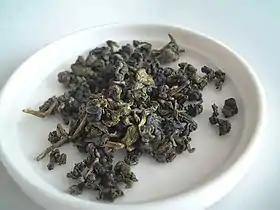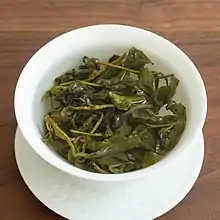Oolong
Oolong ( /ˈuːlʊŋ/; simplified Chinese: 乌龙; traditional Chinese: 烏龍 (wūlóng, "black dragon") is a traditional semi-oxidized Chinese tea (Camellia sinensis) produced through a process including withering the plant under strong sun and oxidation before curling and twisting.[1] Most oolong teas, especially those of fine quality, involve unique tea plant cultivars that are exclusively used for particular varieties. The degree of oxidation, which varies according to the chosen duration of time before firing, can range from 8 to 85%,[2] depending on the variety and production style. Oolong is especially popular in south China and among Chinese expatriates in Southeast Asia[3] as is the Fujian preparation process known as the Gongfu tea ceremony.

| Oolong tea | |||||||||||||||||||||
|---|---|---|---|---|---|---|---|---|---|---|---|---|---|---|---|---|---|---|---|---|---|
.svg.png.webp) "Oolong" in Traditional (top) and Simplified (bottom) Chinese characters | |||||||||||||||||||||
| Traditional Chinese | 烏龍茶 | ||||||||||||||||||||
| Simplified Chinese | 乌龙茶 | ||||||||||||||||||||
| Literal meaning | "Black dragon tea" | ||||||||||||||||||||
| |||||||||||||||||||||
Different styles of oolong tea can vary widely in flavor. They can be sweet and fruity with honey aromas, or woody and thick with roasted aromas, or green and fresh with complex aromas, all depending on the horticulture and style of production.[1] Several types of oolong tea, including those produced in the Wuyi Mountains of northern Fujian, such as Da Hong Pao, are among the most famous Chinese teas. Different varieties of oolong are processed differently, but the leaves are usually formed into one of two distinct styles. Some are rolled into long curly leaves, while others are 'wrap-curled' into small beads, each with a tail. The former style is the more traditional.
The Chinese term wulong (oolong) was first used to describe a tea in the 1857 text Miscellaneous Notes on Fujian by Shi Hongbao. In Chinese, oolong teas are also known as qingcha (Chinese: 青茶; pinyin: qīngchá) or "dark green teas". The term "blue tea" (French: thé bleu) in French is synonymous with the term oolong.[4]
The manufacture of oolong tea involves repeating stages to achieve the desired amount of bruising and browning of leaves. Withering, rolling, shaping, and firing are similar to black tea, but much more attention to timing and temperature is necessary.[5]
Possible origins
The exact origin of the term is impossible to state with certainty. There are three widely espoused explanations of the origin of the Chinese name.[6] According to the "tribute tea" theory, oolong tea came directly from Dragon-Phoenix Tea Cake tribute tea. The term oolong tea replaced the old term when loose tea came into fashion. Since it was dark, long, and curly, it was called Black Dragon tea.
According to the "Wuyi" theory, oolong tea first existed in the Wuyi Mountains region. This is evidenced by Qing-dynasty poems such as Wuyi Tea Song (Wuyi Chage) and Tea Tale (Chashuo). It was said that oolong tea was named after the part of the Wuyi Mountain where it was originally produced.
According to the "Anxi" theory, oolong tea had its origin in the Anxi oolong tea plant, which was discovered by a man named Sulong, Wulong, or Wuliang.
Another tale tells of a man named Wu Liang (later corrupted to Wu Long, or Oolong) who discovered oolong tea by accident when he was distracted by a deer after a hard day's tea-picking, and by the time he remembered to return to the tea it had already started to oxidize.[7]
Varieties
Fujian
Tea production in Fujian is concentrated in two regions: the Wuyi Mountains and Anxi County. Both are major historical centers of oolong tea production in China.
Wuyi Mountains


The most famous and expensive oolong teas are made here, and the production is still usually accredited as being organic. Some of the better known cliff teas are:
- Da Hong Pao ("Big Red Robe"): a highly prized tea and a Si Da Ming Cong tea. This tea is also one of the two oolong varieties classed as Chinese famous teas.
- Shui Jin Gui ("Golden Water Turtle"): a Si Da Ming Cong tea.
- Tieluohan ("Iron Arhat"): a Si Da Ming Cong tea.
- Bai Jiguan ("White Cockscomb"): a Si Da Ming Cong tea. A light tea with light, yellowish leaves.
- Rougui ("Cassia"): a dark tea with a spicy aroma.
- Shui Xian ("Narcissus"): a very dark tea. Much of it is grown elsewhere in Fujian.
Anxi
- Tieguanyin ("Iron Goddess of Mercy"): a China Famous Tea.
- Huangjin Gui ("Golden Cassia" or "Golden Osmanthus"): similar to Tieguanyin, with a very fragrant flavor.
Guangdong

- Single Bush Dancong (单 枞) ("Phoenix oolong")
- A family of strip-style oolong teas from Guangdong Province. Dancong teas are noted for their ability to naturally imitate the flavors and fragrances of various flowers and fruits, such as orange blossom, orchid, grapefruit, almond, ginger flower, etc.
The term dancong originally meant phoenix teas all picked from one tree. In recent times though it has become a generic term for all Phoenix Mountain oolongs. True dancongs are still produced, but are not common outside China.
Taiwan
Tea cultivation in Taiwan began in the 18th century. Since then, many of the teas which are grown in Fujian province have also been grown in Taiwan.[8] Since the 1970s, the tea industry in Taiwan has expanded at a rapid rate, in line with the rest of the economy. Due to high domestic demand and a strong tea culture, most Taiwanese tea is bought and consumed in Taiwan.
As the weather in Taiwan is highly variable, tea quality may differ from season to season. Although the island is not particularly large, it is geographically varied, with high, steep mountains rising abruptly from low-lying coastal plains. The different weather patterns, temperatures, altitudes, and soil ultimately result in differences in appearance, aroma, and flavour of the tea grown in Taiwan. In some mountainous areas, teas have been cultivated at ever higher elevations to produce a unique sweet taste that fetches a premium price.[8]
- Dongding ("Frozen Summit" or "Ice Peak"): Named after the mountain in Nantou County, Central Taiwan, where it is grown. This is a tightly rolled tea with a light, distinctive fragrance.
- Dongfang Meiren ("Oriental Beauty"): This tea is tippy (the leaves frequently have white or golden tips), with natural fruity aromas, a bright red appearance, and a sweet taste.
- Alishan oolong: Grown in the Alishan area of Chiayi County, this tea has large rolled leaves that have a purple-green appearance when dry. It is grown at an elevation of 1,000 to 1,400 metres. There is only a short period during the growing season when the sun is strong, which results in a sweeter and less astringent brew. It produces golden yellow tea with a unique fruity aroma.[9]
- Lishan (梨山) oolong: Grown near Lishan mountain in the north-central region of Taiwan, this tea is very similar in appearance to Alishan teas. It is grown at an elevation above 1,600 metres, with Dayuling, and Fushou being the well known regions and teas along Lishan. [10]
- Pouchong: the lightest and most floral oolong, with unrolled leaves of a light green to brown color. Originally grown in Fujian, it is now also widely cultivated and produced in Pinglin Township near Taipei.
- Ruan Zhi: a light variety of oolong tea. The tea is also known as Qingxin and as # 17. It originates from Anxi in Fujian province.
- Jin Xuan: a variety of oolong tea developed in 1980. The tea is also known as "Milk Oolong" (Nai Xiang) because of its creamy, smooth, and easy taste. Traditional milk oolong tea does not contain milk. It originates from Taiwan.
- Black Oolong: may refer to a dark roasted oolong. This will have a roasted flavor similar to dark roast coffee.
- High-mountain or gaoshan: refers to several varieties of oolong tea grown in the mountains of central Taiwan. Includes varieties such as Alishan, Wu She, Li Shan and Yu Shan.[11]
- Tieguanyin: Muzha Tea Co. brought the tea from Anxi County and developed Taiwan's own variation of the popular tea on the hills of Muzha area near Taipei. While the techniques they used were similar to Anxi tieguanyin, the tastes have evolved during over a century of development.
Other varieties
- Darjeeling oolong: Darjeeling tea made according to Chinese methods
- Assam smoked oolong: Assam's tea made according to Chinese methods, and smoked over open fire
- Vietnamese oolong
Preparation

Recommended brewing techniques for oolong tea vary widely. One common method is to use a small steeping vessel, such as a gaiwan or Yixing clay teapot, with a higher than usual leaf to water ratio.[12] Such vessels are used in the gongfu method of tea preparation, which involves multiple short steepings.[13]
For a single infusion, 1 to 5-minute steepings are recommended, depending on personal preference.[14] Recommended water temperature ranges from 82°C to 96°C (180 to 205°F.)[14][12]
Caffeine
Oolong contains caffeine,[15] although the caffeine content in tea will vary based on terroir, when the leaf is plucked, and the production processes.
Teaghrelins
Some semi-oxidized oolong teas contain acylated flavonoid tetraglycosides, named teaghrelins due to their ability to bind to ghrelin receptors. Teaghrelins were isolated from Chin-shin oolong tea[16] and Shy‐jih‐chuen oolong tea[17] and recently from other oolong tea varieties.
See also
| Wikimedia Commons has media related to Oolong. |
Notes
References
- Zhongguo Chajing pp. 222–234, 271–282, 419–412, chief editor: Chen Zhongmao, publisher: Shanghai Wenhua Chubanshe (Shanghai Cultural Publishers) 1991.
- 施海根,中國名茶圖譜、烏龍茶黑茶及壓製茶花茶特種茶卷 p2,上海文化出版社 2007 ISBN 7-80740-130-3
- Joseph Needham, Science and Civilization in China, vol. 6, Cambridge University Press, 2000, part V, (f) Tea Processing and Use, pp. 535–550 "Origin and processing of oolong tea".
- van Driem 2019, p. 129.
- Donaldson, Babette (1 January 2014). The Everything Healthy Tea Book: Discover the Healing Benefits of Tea. F+W Media. ISBN 9781440574597.
- Richard Goodness"Oolong Tea: Covering the Basics".
- Fergus Ray-Murray, "Oolong (Wu Long) Tea"., oolong.co.uk
- Guang Chung Lee (2006). "The Varieties of Formosa Oolong". Art of Tea. Archived from the original on 5 March 2014. Retrieved 12 December 2006., Issue 1 www.the-art-of-tea.com
- The Tea Cup, "Oolong Tea". Archived from the original on 11 April 2010. Retrieved 22 October 2006., theteacup.co.uk
- 梨山茶區, jpstea.com.tw https://www.jpstea.com.tw/pages/%E6%A2%A8%E5%B1%B1%E8%8C%B6%E5%8D%80#:~:text=%E6%A2%A8%E5%B1%B1%E8%8C%B6%E5%8D%80%E4%BD%8D%E6%96%BC%E5%8F%B0%E4%B8%AD,%E4%B8%8B%E9%9B%AA%EF%BC%8C%E8%8C%B6%E8%91%89%E7%94%9F%E9%95%B7%E7%B7%A9%E6%85%A2%E3%80%82. Retrieved 28 January 2021. Missing or empty
|title=(help) - "Exploring Alishan tea and other Taiwan high mountain gao shan teas". theteadetective.com.
- Liz Clayton (2011). "Tea Technique: Steeping Oolong". Serious Eats. Retrieved 10 August 2019.
- Heiss & Heiss 2012, p. 308.
- Emily Han (2014). "How To Brew Oolong Tea". The Kitchn. Retrieved 10 August 2019.
- Metropulos, Megan; Ware, Megan (2017). "What are the health benefits of oolong tea?". Medical News Today. Retrieved 28 December 2019.
- Lo, Yuan-Hao; Chen, Ying-Jie; Chang, Chi-I; Lin, Yi-Wen; Chen, Chung-Yu; Lee, Maw-Rong; Lee, Viola S. Y.; Tzen, Jason T. C. (2014). "Teaghrelins, Unique Acylated Flavonoid Tetraglycosides in Chin-Shin Oolong Tea, Are Putative Oral Agonists of the Ghrelin Receptor". Journal of Agricultural and Food Chemistry. 62 (22): 5085–5091. doi:10.1021/jf501425m. PMID 24832927.
- Li, Yue‐Chiun; Wu, Chieh‐Ju; Lin, Yi‐Chiao; Wu, Ruo‐Hsuan; Chen, Wen‐Ying; Kuo, Ping‐Chung; Tzen, Jason T. C. (2019). "Identification of two teaghrelins in Shy‐jih‐chuen oolong tea". Journal of Food Biochemistry. 43 (4): e12810. doi:10.1111/jfbc.12810. PMID 31353599.
Further reading
- Heiss, Mary Lou; Heiss, Robert J. (2012). The Tea Enthusiast's Handbook: A Guide to the World's Best Teas. Potter/TenSpeed/Harmony. ISBN 1607743787.
- van Driem, George L. (2019). The Tale of Tea: A Comprehensive History of Tea from Prehistoric Times to the Present Day. BRILL. ISBN 9-0043-9360-9.
